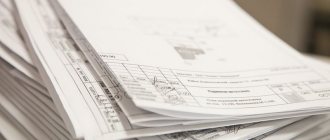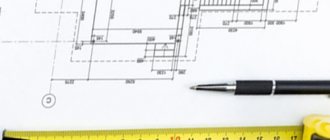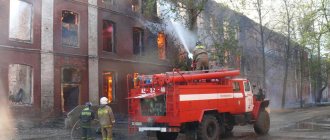At the end of the procedure, the customer is given a package of documents, which indicates all the results of inspections, analysis, and the cost of a specific property. All papers are legally certified.
The technical report contains the following information:
- History of the building.
The area where it is located.
Equipment inspection report
Equipment Inspection Certificate – a paper documenting the inspection procedure for devices/equipment. It also reflects the results of the event and any defects found. Typically, a document is created by company employees as part of an inspection of equipment that:
- operated by the company;
- purchased for subsequent sale;
- offered for rent;
- arrived at the warehouse for maintenance/repair;
- arrived at the warehouse for safekeeping.
Typically, an inspection is carried out after or before an event. For example, equipment that was recently purchased is inspected. Regardless of the reasons for the inspection, it is necessary to draw up a report as part of the procedure. In most cases, it is not self-sufficient. It complements other papers: agreement, deed of transfer, and so on.
Purpose of the commission survey
The main purpose of inspecting the premises is to determine its technical condition, suitability for use , as well as the possible price for sale (rent).
Drawing up an act is mandatory in the following cases:
- Purchase and sale (this follows from the obligation of the buyer of the premises to accept it as a product, in accordance with Article 454 of the Civil Code of the Russian Federation (hereinafter referred to as the Civil Code)).
- In case of spills, fire and other cases where damage is caused to the premises.
IMPORTANT: the act of spilling (causing harm for other reasons) will be important. proof of the fact of harm, both in the pre-trial settlement of the dispute, and if the case goes to court. - Upon completion of contract repair work (Article 720 of the Civil Code). In all other situations, the fact of inspection of the premises may not be activated.
Functions
The inspection report solves the following tasks:
- Recording of detected damage that can be seen with the naked eye.
- Documentary confirmation of complete equipment.
- Confirmation that the equipment is in working order.
- Establishing compliance of devices with the technical passport.
- Documentary confirmation that the equipment meets fire and sanitary safety standards.
Inspections can be either one-time or regular. But, in any of these cases, it is necessary to draw up an act. It performs these functions:
- Prevention of production failures/breakdowns.
- Establishing that the equipment can be operated.
Inspection is the most important element needed to ensure safety. Based on the certificate, the equipment is put into operation. If the commission cannot give permission to use the equipment, the act must contain the grounds for refusal. In particular, the document must contain these provisions:
- Degree of wear.
- Defects found.
- Approximate cost of eliminating detected defects.
- Approximate time frame for repair work.
Sometimes detected defects cannot be corrected. In this case, based on the inspection report, the equipment is written off from the company’s balance sheet.
Rules for drawing up an act
There is no statutory sample of a residential premises inspection report; it can be filled out in any form. Organizations may provide their own template for this document. Writing by hand or typing on a computer is equally important, as long as the document contains the necessary minimum information:
- data about the object being examined;
- composition of the commission and information about its members;
- conclusions drawn based on the inspection;
- deficiencies discovered during the procedure;
- comments.
If the need for inspection arose as a result of disputes about the amount of damage caused to the home, it is necessary to note in the report the cause, the alleged culprit and the discovered cause-and-effect relationships. Based on the inspection, the court must make a decision to punish the culprits. When it comes to the common property of apartment owners in an apartment building, damage is compensated in the share that each property owner has.
Important! The act is drawn up in various forms: description or tables. The choice depends on how best to present information for easy understanding.
The complexity of the arrangement of a living space affects the volume of the act drawn up; any sample gives only an idea of the basis of what it should contain. When inspecting the room, common property in an apartment building and other objects are photographed, and the photos are included in the report as attachments. When analyzing the technical condition of the ventilation system, electrical network, heating, water supply and other communications, data on its compliance with accepted standards is entered into the form.
Important! If the act contains appendices, information about their presence is in the main part of the document.
The number of copies of the act depends on the number of parties involved in the dispute; each receives one form. Members of the commission put their signatures on all copies of the act; to confirm the authenticity, the seals of organizations related to the verification are affixed. Only if this condition is met, the document drawn up has legal force.
Rules for drawing up the act
Typically, equipment inspection is carried out by a commission. Typically, it consists of company representatives from various departments: engineers, deputy managers, technologists, lawyers.
There is no unified form of inspection report. The document can be created in free form. When compiling it, samples approved by the head of the company can also be used. The form of the act must be recorded in the accounting policy.
To draw up the document, you can use plain paper or company letterhead. The text can be either written or printed. It is possible to fill out the form electronically. But, if it was compiled in electronic form, you need to print it out and then certify the document with the signatures of all members of the commission.
The document is drawn up in several copies. One remains with the company. Other copies are handed over to the persons involved in the inspection.
ATTENTION! The inspection report does not need to be sealed. This should be done only when there is a corresponding provision in the company’s accounting policies.
How to prepare an apartment inspection report
The content and structure of a document are determined by its purpose. As well as those persons who compose and design it. For example, in the case of flooding an apartment, such a document is drawn up by representatives of the organization that operates and manages the house (HOA, management company, etc.). For the purposes of purchase and sale, rental of real estate, an apartment inspection report is drawn up by the seller and the buyer with the participation of 2 invited persons. We especially recommend drawing up an inspection report in case of renting - to minimize the likelihood of demanding compensation for damage that already existed at the time of renting out the property from the new tenant.
An incorrectly drawn up act can lead to the appointment of various types of examinations in a civil case. Which entails additional costs and waste of time. By the way, if for some reason the act drawn up by the commission with the participation of the HOA seems incorrect to you, the homeowner has the right, with the participation of 2 or more witnesses, to prepare his own inspection report and seek in court to accept it as evidence in a civil case (recognizing “ not your own” act is unacceptable evidence).
Contents of the act
The contents of the inspection report can be divided into 3 parts: “header”, main part and conclusion. The header contains this information:
- Company name.
- Document's name.
- Date and place of registration.
The main part contains these provisions:
- Members of the commission (full name, position).
- Information about the equipment: model, article number, manufacturer, inventory number.
- Stages of inspection: external inspection, installation, startup.
- Results of the event. It is necessary to write in as much detail as possible about the condition of the equipment and any defects found.
- Results of the commission's activities. Here the general opinion of the participants is recorded, as well as the conclusions of each of them.
Additional materials may be attached to the report. For example, photos and videos. In this case, the act must include a list of annexes.
Premises inspection procedure
When making a purchase, sale, rental and other transactions with real estate, an inspection report of a residential premises is not necessary, however, it can help for a successful conclusion of the transaction. It is mandatory to draw up when ordering a forensic examination or for carrying out investigative measures.
There are no strict regulations on the procedure; the law specifies only general requirements. The most common cases are when a survey is carried out to achieve a specific goal:
- checking the general technical condition of the facility;
- checking the functionality of the electrical network or other communications;
- monitoring compliance with fire or environmental safety rules.
Important! The purpose of the procedure influences the specific content of the inspection report.
To carry out the procedure, a commission of two or more people is formed. Performing such work by one person is not permitted in accordance with current law. The commission includes representatives of various departments and authorities, including: experts, technicians, engineers and other specialists. Rules are needed to ensure the objectivity of the inspection and obtain a reliable result so that all parties to the conflict are satisfied.
Premises inspection report
A premises inspection report may be drawn up under the following circumstances:
- Purchasing an apartment/office.
- Renting premises.
- Damage to the premises due to an emergency (fire, flood, etc.).
- An examination of the premises is required for the subsequent submission of the document to the court.
The main purpose of the inspection report is to record defects or their absence. The law does not establish the form of the document in question. But it must meet a number of requirements. In particular, it must contain mandatory details: date and place of execution, composition of the commission, title of the document. The report lists in detail all detected defects. The document must include the opinions of experts included in the commission. The inventory report will not be valid without the signatures of the commission members and the persons conducting the inspection.
Example of an apartment inspection report
September 28, 2021 Tolyatti
Apartment inspection report
after flooding
Based on the application of the owner of the property, Pogrebnyak Valery Vasilyevich No. 168vkh dated September 28, 2017, regarding the flooding of the apartment, a commission consisting of:
Chairman of the Homeowners Association "DomNash" Veretennikova Anna Vladimirovna, engineer of the Homeowners Association "DomNash" Kirichuk Sergey Sergeevich,
conducted a study of apartment No. 48 on Yadrintseva Street, Building No. 93, Tolyatti. The apartment is located on the 2nd floor of a 9-story building built in 1978, 2-room. Owned by Valery Vasilyevich Pogrebyanyak since 02/15/2002.
On the day of the inspection, it was established that September 28, 2021 at 17:00. 40 min. local time from Pogrebnyak V.V. Request No. 168вх was received, leaking from the ceiling. The emergency team arrived at 6 p.m. 00 min., the riser is closed at 18 o'clock. 05 min. The cause of the flooding is a leak in the heating radiator in the living room of apartment No. 52 (replaced by the owner of the said property, Viktor Andreevich Poddubny).
The following premises and furniture were damaged during the flooding:
- Bedroom, S = 18 sq. m., renovation was carried out in 2012 (according to the owner)
The ceiling is whitewashed, completely filled. Wet spots, stains all over the ceiling.The walls are non-woven wallpaper. Wetting and peeling at the joints of the wallpaper on the right side, peeling from the wall along the central side along the window.
The floor is parquet. Blistering and cracks throughout the entire floor area.
The window is plastic. Swelling of window sill plastic.
The interior wooden door is swollen, warped and does not close.
The room has furniture: Samsung TV, wet, burnt out, carpet (natural wool) - completely wet, stained, corner sofa - wet.
- Corridor, S = 5 sq. m., renovation 2012 (according to the owner)
The floor is parquet. Bulging and cracks, area 2 sq. m.
Wallpaper is simple, paper. Wet spots and stains along the central part of the corridor near the interior door.
The ceiling is whitewashed and was not damaged. The furniture in the hallway was not damaged.
- The rest of the apartment was not damaged.
The commission’s conclusion: Damage to the apartment was caused by a flood due to a leak in the heating radiator in the living room of apartment No. 52.
Inspection started: 6 p.m. 25 min. Inspection completed: 6 p.m. 35 min.
The owner of apartment No. 48, Valery Vasilyevich Pogrebnyak, and the owner of apartment No. 52, Viktor Andreevich Poddubny, were present during the inspection.
Signatures of the parties:
Chairman of the Homeowners Association "DomNash" Veretennikova Anna Vladimirovna
Engineer of the Homeowners Association "DomNash" Kirichuk Sergey Sergeevich
Owner of apartment No. 48 Pogrebnyak Valery Vasilievich
The owner of apartment No. 52 is Viktor Andreevich Poddubny. He refused to sign in the presence of members of the commission. He did not give reasons for his refusal.
Writing Instructions
Although there is no specific pattern or form for the act, many adhere to the template. According to it, the document has the following components:
- name and purpose of application, name of the locality and date (day, month and year);
- composition of the commission with full information on each member (full name, position, name of the represented organization);
- information about the object under study (name, purpose, location address, full name of the owner);
- conclusions about the condition of the object (if there are faults, describe them in detail);
- signatures from members of the inspection commission and certification with seals.
This example helps to get the general idea. Depending on the purpose of the study, the report contains additional information. For example, in apartment buildings, inspections may be carried out twice a year, in the spring and autumn. Such seasonal inspections are necessary to prepare for the winter period and assess the exit from it in the spring, which means the commission must draw conclusions about the condition of the building. The need to inspect the house in the spring and autumn is specified in the contract with the service organization.
Certificate of seasonal inspection of apartment buildings
Application of the act
An assessment of the condition of housing premises is required in various situations; most often it becomes necessary to record the damage caused and go to court. When drawing up an act, it is important to fulfill the basic requirements.
The absence of one of the required components will cause the document to lose its legal force.
To avoid such situations, the legislation contains strict requirements regarding the formation of the commission.
Damage can be caused in different ways, so the composition of experts and other members of the commission must correspond to the specifics of the task at hand. Common reasons for testing include:
- fire;
- flooding of residential premises;
- damage to property by third parties.
A correctly drawn up inspection report of the premises becomes a good reason for obtaining a decision from the court that satisfies the plaintiff. Information about damage becomes the basis for compensation. Often in court proceedings, the inspection act becomes the decisive argument for winning the dispute. In other cases, the document is also important; when purchasing or renting, it helps to ensure the interested party in the normal condition of the object.








